Top Pickleball Paddle Recommendations for Intermediate Players
Now that we've discussed essential factors to consider in choosing the right paddle, let's explore some of the top recommendations available for intermediate players. These paddles exemplify quality, performance, and are specially crafted to meet the needs of players at this skill level.
Best Overall: Franklin Sports Pro
The Franklin Sports Pro pickleball paddle stands out as an optimal choice for intermediate players due to its combination of control and power. Weighing between 7.3 to 8.1 ounces, it allows for excellent maneuverability without sacrificing the ability to deliver powerful shots.
Features of the Franklin Sports Pro include a composite polymer face that enhances durability, alongside a large sweet spot for improved shot accuracy. The paddle's design makes it particularly suitable for players transitioning from tennis, especially those utilizing a two-handed backhand.
Pros:
- Excellent balance of power and control
- Durable and consistent performance
Cons:
- Some may find it slightly heavier compared to other options
Best Performance: Head Extreme Tour
Another great option is the Head Extreme Tour paddle, which appeals to intermediate players seeking enhanced control and power. Weighing around 7.2 ounces, this paddle's design includes a graphite face that contributes to excellent spin potential and shot precision.
One unique attribute of the Head Extreme Tour is its aerodynamic diamond shape, which facilitates faster swings, allowing for aggressive play without sacrificing accuracy. The ergonomic grip further enhances comfort during extended matches.
Pros:
- Lightweight and maneuverable
- Excellent control features
Cons:
- Performance may vary for players prioritizing power over finesse
Best for Spin: JOOLA Ben Johns Hyperion CGS
The JOOLA Ben Johns Hyperion CGS paddle is designed to enhance maneuverability, making it ideal for intermediate players who value speed and comfort. Featuring a unique Carbon Grip Surface (CGS) technology, this paddle excels in providing advanced spin control, empowering players to execute precise shots with ease.
Additionally, the Aero Curve design minimizes drag, promoting better swing speeds during fast-paced exchanges. The Response Polymer Core provides a comfortable feel by reducing vibrations on impact, perfect for those long play sessions.
Pros:
- Fantastic spin control and rapid maneuverability
- Vibrational reduction for improved comfort
Cons:
- Pricing may be higher compared to others in its class
Best All-court: Onix Z5
The Onix Z5 is a widely respected all-around paddle that meets the needs of many intermediate players. Its graphite face combined with a Nomex honeycomb core provides excellent touch and control, ensuring players can execute both precise placements and powerful strikes effectively.
This paddle's unique wide body shape enhances the sweet spot, making it more forgiving on off-center hits, which can be crucial for developing players. Furthermore, the Onix Z5 is known for its comfortable grip, allowing longer periods of uninterrupted play.
Pros:
- Versatile for various playing styles
- Large sweet spot increases shot consistency
Cons:
- The added width may affect maneuverability for some
Best for Power: CRBN2X
The CRBN2X paddle is recognized for delivering a balanced combination of power and spin, making it a favorite among intermediate players looking to enhance their performance. This paddle features a raw carbon fiber face that improves spin potential, making it easier to execute topspin and slice shots effectively.
The polypropylene core balances control and power while ensuring responsiveness during fast-paced exchanges, allowing players to be versatile in their shot selection.
Pros:
- High spin potential for strategic play
- Balanced power and control characteristics
Cons:
- May require an adjustment period for those unfamiliar with its feel
Best for Control: Selkirk SLK Evo Hybrid Max 2.0
For players transitioning from beginner to intermediate, the Selkirk SLK Evo Hybrid Max 2.0 presents an excellent option. This paddle is lightweight, making it easy to handle while still delivering powerful shots when needed.
Equipped with a rev-hybrid polymer core, this paddle balances control and responsiveness, while the C7-Flex hybrid fiberglass face provides the necessary power for aggressive shots. With its ergonomic grip, the Selkirk model prioritizes comfort, making it ideal for extended gameplay.
Pros:
- Lightweight for enhanced maneuverability
- Comfortable grip promotes prolonged play
Cons:
- Power may be less pronounced compared to heavier paddles
Finding the Right Paddle as an Intermediate Player
Moving into the realm of intermediate pickleball play signifies that you've developed a solid grasp of the game, including familiarity with the rules and consistency in executing fundamental shots. This stage is also characterized by a budding sense of strategy as players begin to understand the importance of positioning, shot selection, and overall game dynamics. Upgrading from a beginner paddle is not just a matter of preference; it is essential for enhancing performance and encouraging further skill development.
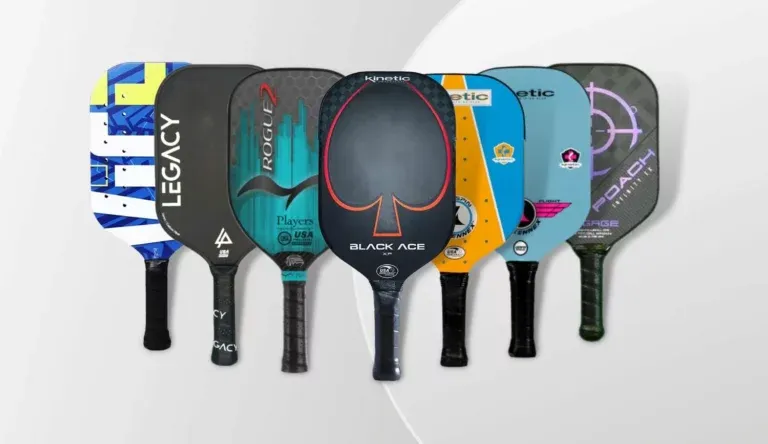
Transitioning from a beginner paddle, which often lacks responsiveness and precision, to a paddle that offers more advanced features can drastically improve your game. Intermediate players should prioritize paddles that allow for aggressive shots while still maintaining finesse, accommodating various playing styles from power hitters to those who prefer control and placement. With numerous options available, researching and identifying the specific features that resonate with your playing style is crucial.
As you begin this search, you may encounter a variety of paddles with differing materials, weights, and technical specifications. Understanding your needs and the characteristics that make a paddle suitable for your level of play will guide you toward making an informed decision. Our goal here is to provide precise recommendations along with information on essential factors to consider when choosing your next paddle, ensuring you find the perfect fit to elevate your pickleball experience.
Understanding the Needs of an Intermediate Pickleball Player
The journey from beginner to intermediate in pickleball is marked by several key transitions in skill and understanding. At the intermediate level, players generally have the following characteristics:
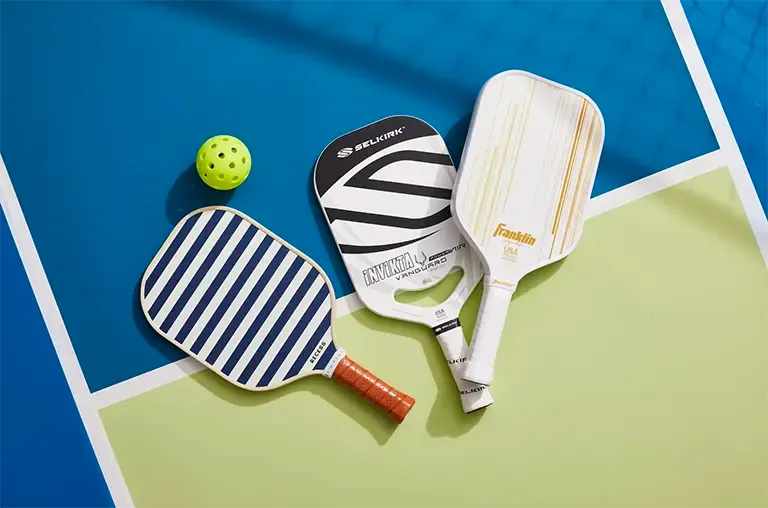
- Consistency: You can hit accurate forehands, backhands, volleys, and overheads with increasing reliability, translating to fewer errors during play.
- Developing Power and Control: You start to generate more power in your shots while also improving your ability to control the ball's placement.
- Strategic Play: A fundamental understanding of basic strategies comes into play, including when to attack and when to defend. You begin to implement these strategies during matches.
- Reduced Unforced Errors: The focus on maintaining consistency leads to a reduction in unforced errors as you manage shot selection and risk more effectively.
- Improved Serving Skills: Serving skills are enhanced as you learn to incorporate spin and varying speeds, making your serves more challenging for opponents.
Understanding your unique playing style is critical during this phase as different players will evolve in distinct ways. Some might gravitate toward a more control-oriented game, preferring paddles that offer precision, while others may adopt a more aggressive, power-based strategy. The choice of paddle must take into account these developing preferences, which not only reflect your current capabilities but also your potential growth areas.
Common playing styles include:
- Control-oriented Players: These players focus on shot placement, accuracy, and finesse. They need paddles that provide touch and gentle feedback.
- Power-oriented Players: Aimed at generating strong, aggressive shots, these players benefit from paddles that balance power and reaction time.
- All-rounded Players: This approach combines both control and power elements; finding a paddle that caters to both areas is essential.
Crafting a solid foundation of skills and understanding helps intermediate players refine their technique and begin the journey toward more advanced levels of play.
See more: Top 6 Best Pickleball Paddles for Advanced Players in 2025
Key Factors to Consider When Choosing an Intermediate Pickleball Paddle
Having recognized the unique needs of intermediate players, let's delve into the critical factors when selecting the right paddle. Every element of paddle construction influences how it will perform on the court, ultimately impacting your game.
Weight
The weight of a pickleball paddle plays a significant role in performance, typically falling within a range of 7.0 to 8.5 oz for intermediate players. Selecting the right weight depends on your style of play and comfort level.
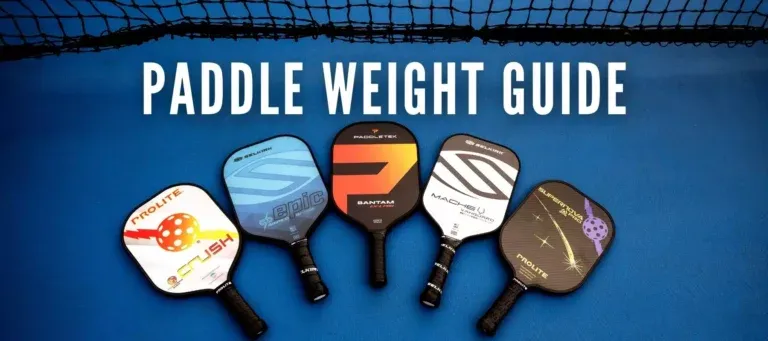
- Benefits of Mid-weight Paddles (7.5-8.5 oz):
- Balance of Control and Power: This weight range typically offers a good balance, allowing for both powerful striking and consistent control.
- Swing Speed: A mid-weight paddle enables quicker swing speeds, providing agility without sacrificing stability.
- Fatigue Management: Heavier paddles may lead to quicker fatigue during extended games, while lighter paddles may not generate the necessary power.
Ultimately, the ideal weight should correspond to your physical capabilities and game strategy.
Grip Size and Length
Grip size and length are often overlooked but are vital for comfort and control during play. The recommended circumference for intermediate players usually falls between 4.0 to 4.5 inches. Here's why grip dimensions matter:
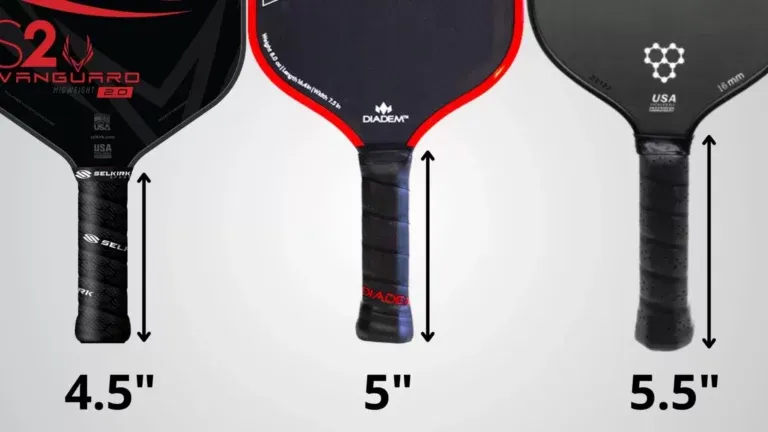
- Comfort: An appropriately sized grip allows better control and less strain during play. A grip that is too large may lead to decreased hand sensitivity, and one that is too small can result in a lack of control.
- Impact on Shot Selection: The length of your grip can affect your two-handed backhands. Longer grips enable more comfortable two-handed shots, while shorter grips are better for finesse plays.
Choosing a grip that feels natural in your hand ultimately aids in shot accuracy, reducing unwanted slips.
Paddle Face Material
Paddle face materials significantly influence your overall game performance, with common materials including:
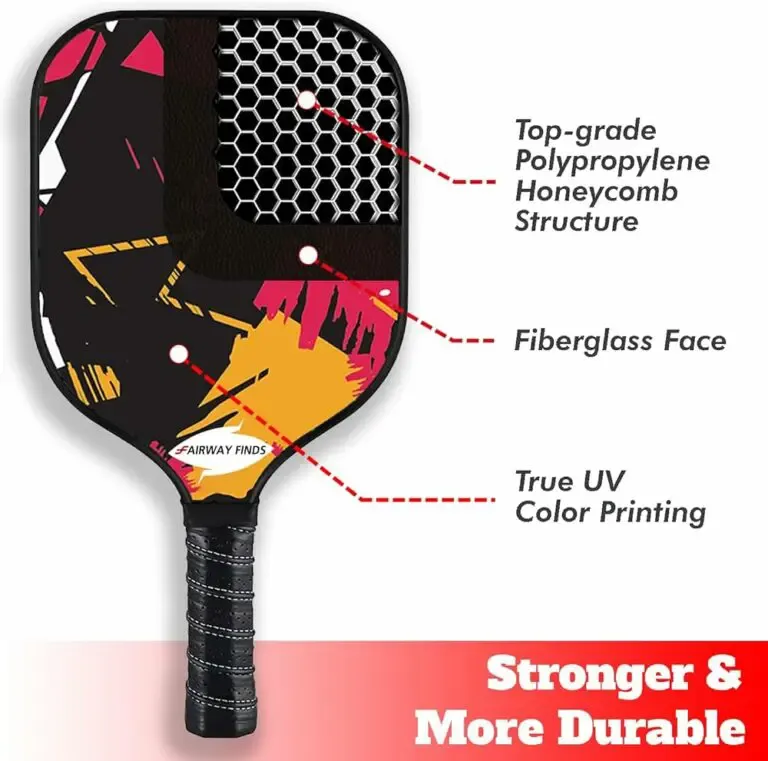
- Graphite: Lightweight and providing excellent control and spin, ideal for players focused on touch and placement.
- Fiberglass: Offers power and durability, often at a more affordable price point. It helps create a larger sweet spot for forgiving shots.
- Composite: These paddles combine the benefits of both graphite and fiberglass, delivering balance and versatility.
Understanding how these materials influence performance is key for tailoring your paddle choice to your specific game needs.
Core Material and Thickness
The core of the paddle has a significant impact on its playability, primarily affecting touch and control. Common core materials include:
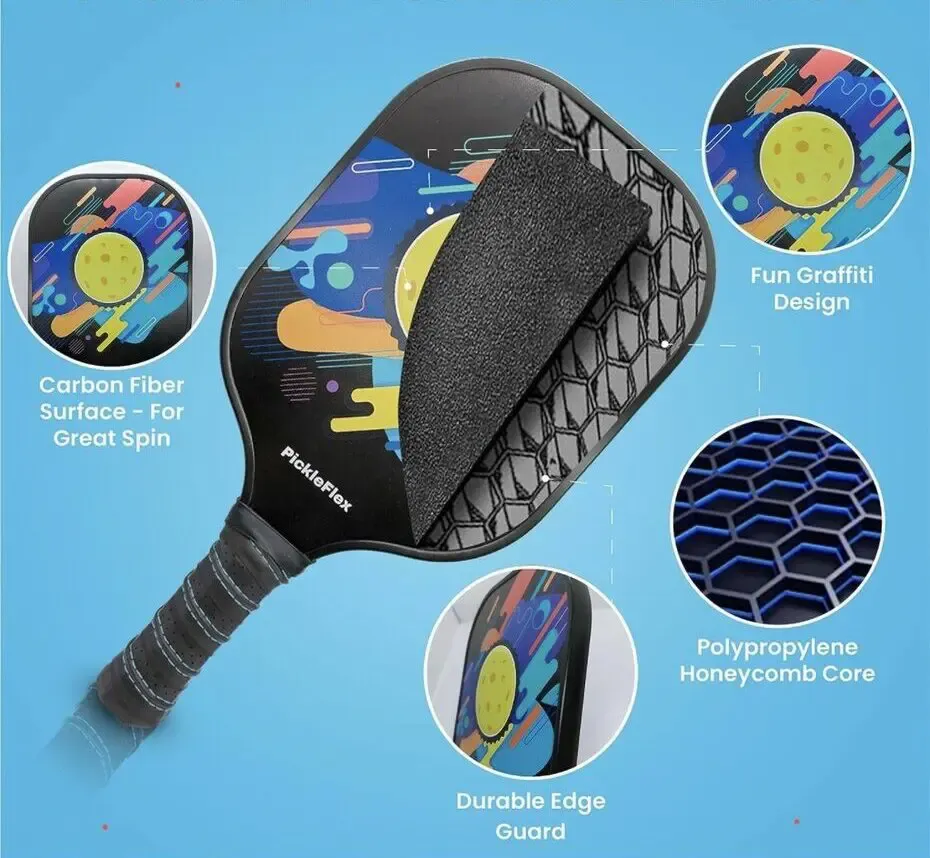
- Polymer Honeycomb: Provides a softer feel, excellent for control and reducing vibrations on impact, making it favorable for precision shots.
- Nomex: Offers excellent durability and a bit more pop for powerful shots, beneficial for aggressive players.
The thickness of the core also matters:
- Standard Thickness (13mm to 16mm): Thicker cores typically offer greater control, while thinner cores provide more speed and power.
Choosing the right core type and thickness significantly influences the paddle's responsiveness and feel during gameplay.
Paddle Shape and Size
The shape of the paddle impacts maneuverability and playability. Standard shapes provide precision, whereas elongated paddles offer extra reach.
Considerations such as width also come into play. Wider paddles offer a larger sweet spot, making them more forgiving on off-center hits.
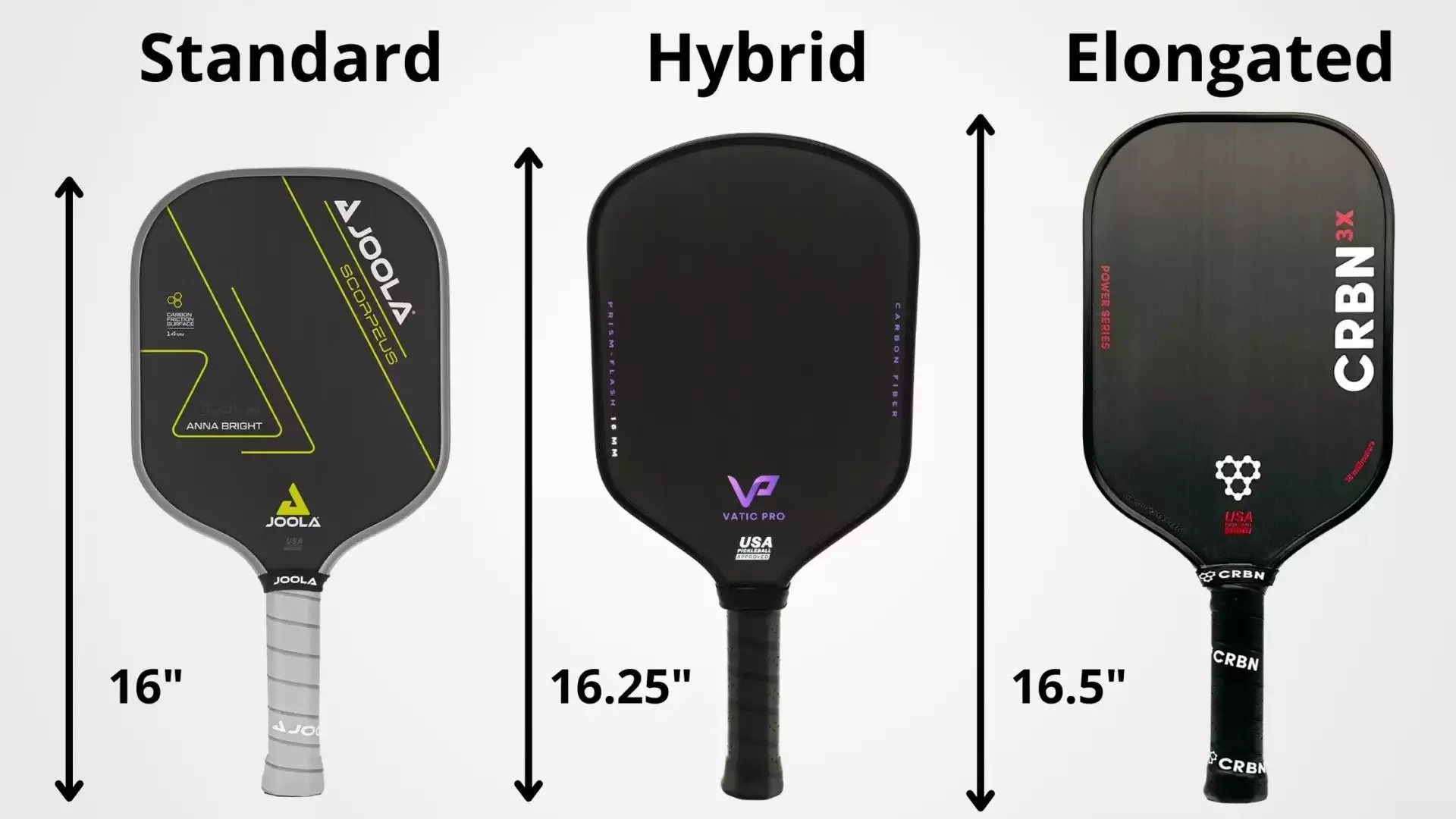
Balance
The balance of a pickleball paddle affects its maneuverability during play. There are generally three types of balance:
- Head-Heavy: Provides more power for aggressive shots but can be challenging for quick reactions.
- Head-Light: Offers enhanced maneuverability, favoring players who rely on touch and quick strokes.
- Even Balanced: A compromise between power and control, suitable for most intermediate players.
Finding the right balance is crucial for optimizing performance, especially during fast exchanges and quick decision-making moments on the court.
Sweet Spot Size
The sweet spot of a paddle refers to the area on the face where the ball will connect optimally for the best shot results. A larger sweet spot means more forgiveness on off-center hits, which is particularly beneficial for intermediate players still refining their accuracy.
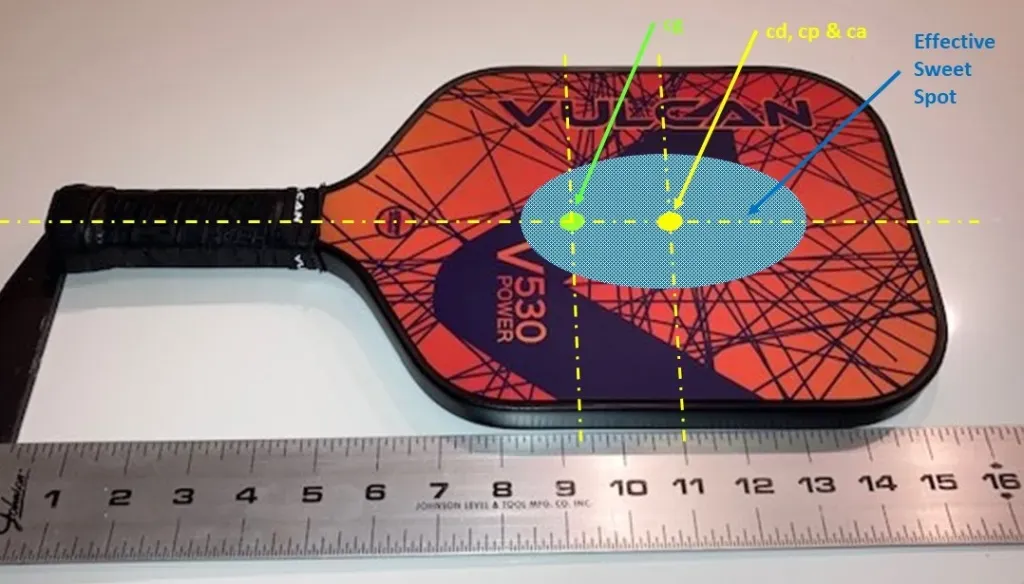
Improving your contact accuracy will provide more consistent shot performance as you advance your skills.
Spin Potential
Generating spin is crucial for adding variety and complexity to your shots. The texture of a paddle face plays a significant role in aiding spin.
- Textured Surfaces: Paddles that incorporate rough surfaces, such as those made from carbon fiber, enhance the ability to grip the ball effectively empowering shots with topspin and slice.
- Control with Spin: Spin allows for controlling the ball's trajectory, making it difficult for opponents to anticipate and return shots effectively.
Given the importance of spin in advanced play, selecting a paddle with high spin potential can elevate your gameplay and strategy.
Durability
Durability is a vital consideration, especially for intermediate players who are likely to use their paddles frequently. Factors include build quality, material selection, and the construction of the core:
- Graphite and Composite Materials: Typically offer superior durability compared to wood.
- Polymer Honeycomb Cores: Not only provide excellent performance but also contribute to paddle longevity, as they resist wear and tear effectively.
Selecting a paddle built with durable materials ensures your investment in equipment will hold up to the endurance of frequent play, positively contributing to your experience.
Price/Budget
When considering price, it is essential to balance your budget with the performance capabilities of the paddle you choose. Intermediate paddles generally range from $50 to $250, with quality options available across various price points.
By setting a budget and researching paddles within that range, you can ensure that you get value for your investment while elevating your game.
How to Choose the Right Pickleball Paddle for Your Intermediate Playstyle
Choosing the right pickleball paddle is not solely about specifications, but it also hinges on your personal playstyle and preferences. Here are some guiding questions to consider as you make your decision:
- What’s Your Most Important Factor?: Do you favor control and finesse in your shots, or are you more inclined toward power and aggressive play?
- Transitioning Players: Are you moving from tennis and seeking a specific paddle feel that reflects your previous experience?
- Playing Style: How frequently do you utilize a two-handed backhand? This will help determine grip length needed for optimal handling.
- Budget Constraints: What is your spending limit for purchasing a paddle?
- Improvement Goals: Are you looking to enhance spin shots specifically, or are you concentrating on strengthening your overall game strategy?
Trying out different paddles is critical to ensuring you find the right fit that suits your unique playing style. Don’t hesitate to consult fellow intermediate players for their recommendations or even engage in practice sessions to experience the feel of various paddles firsthand.
Tips for Intermediate Players to Maximize Paddle Performance
For intermediate players, maximizing paddle performance hinges on several techniques and practices that can significantly improve gameplay. Here are some suggestions:
- Proper Grip Technique: Make sure to use the correct grip style that aligns with your playing preferences. Regularly reassess your grip size and shape to ensure a comfortable hold during play.
- Diverse Shot Techniques: Develop various shot techniques with your chosen paddle, including dinks, drives, and drop shots, to keep opponents guessing and maintain an edge.
- Understanding Paddle Features: Gain a deeper understanding of how your paddle's weight, material, and core type influence your shot quality and adjust play accordingly. For instance, experiment with swing speed and follow-through techniques to optimize shot outcomes.
- Paddle Care: Properly maintain your pickleball paddle by cleaning it after play and storing it in a protective case, which prolongs its life and performance.
- Consider Upgrading: Be mindful of how your skills evolve. Knowing when to transition to a more advanced paddle based on your regular playing experiences is crucial for continued improvement.
By employing these practices, you will enhance your ability to get the best performance from your paddle, supporting your growth as an intermediate player.
Conclusion: Elevating Your Intermediate Game with the Right Paddle
Choosing the right pickleball paddle can profoundly impact your experience as an intermediate player. Prioritizing your individual needs and preferred playing style will enable you to find a paddle that enhances your performance and elevates your gameplay. Remember to consider critical factors such as weight, grip size, material, and core type to ensure your paddle is tailored to your specific requirements.
Investing time in research and, if possible, trying out different paddles will pay dividends, helping you to navigate various playing styles while developing additional skills. As you continue to fine-tune your technique and strategy, the right paddle will not only support your current skillset but also facilitate future improvements. With the insights and recommendations provided, take the leap to find your ideal paddle and level up your game in pickleball!
Frequently Asked Questions (FAQs)
What is the typical USAPA rating for an intermediate player?
The typical USAPA rating for an intermediate player falls between 3.5 and 4.0. Players in this range generally demonstrate consistency during play, maintaining a moderate number of unforced errors while conveying strong knowledge of rules, strategies, and various strokes.
Should intermediate players use a lightweight or heavier paddle?
Lightweight paddles (typically 7–7.5 ounces) enhance agility and control, making it easier to execute quick movements and touch shots. Heavier paddles (8.5-10 ounces) may provide extra power but can reduce maneuverability. Ultimately, the choice should align with personal comfort, playing style, and skill level.
What paddle face material is generally best for intermediate players?
Graphite and carbon fiber face materials are often preferred, as they strike an ideal balance, offering control, touch, and spin. Graphite paddles provide a lightweight feel enhancing precision, while carbon fiber allows for greater spin generation, aiding aggressive players.
Is an elongated or wider paddle better for intermediate pickleball players?
Elongated paddles provide added reach and increased power, whereas wider paddles deliver larger sweet spots, offering better forgiveness on off-center hits. Ultimately, the choice depends on whether a player prioritizes power and reach or control and precision.
How can intermediate players generate more spin?
Intermediate players can generate spin by using paddles with textured surfaces, which enhance grip on the ball, facilitating topspin and slice shots. They should also focus on proper grip techniques, utilizing more wrist motion during their swings to elevate spin levels.
When should an intermediate player consider upgrading their paddle again?
Consider upgrading your paddle when you notice skill improvements, signs of wear and tear on your current paddle, shifts in your playing style, or increased competitiveness in matches. An upgrade can enhance your ability to keep up with evolving gameplay and help you reach the next level.






















